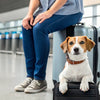What Weight Can a Dog Be to Fly in Cabin: A Comprehensive Guide for Pet Owners
- Houndsy
Table of Contents
- Introduction
- Understanding Airline Policies for In-Cabin Travel
- Preparing for Travel: Health and Safety Considerations
- The Difference Between In-Cabin and Cargo Travel
- Additional Costs and Considerations
- Conclusion
- FAQ
Introduction
Have you ever wondered how much your furry friend weighs in relation to air travel? If you're planning to take your dog on an airplane, understanding the weight limits for flying in the cabin is crucial. Did you know that many airlines allow only small dogs—typically weighing around 20 pounds or less—to travel with their owners in the cabin? This limitation can significantly impact your travel plans, especially if you have a larger dog that you wish to bring along.
In this blog post, we will explore the nuances of flying with dogs, specifically addressing the weight restrictions for cabin travel, the differences between in-cabin and cargo travel, and how to prepare your pet for a smooth journey. Our aim is to provide actionable insights for pet owners, ensuring that you have all the information you need to make your travel experience as enjoyable as possible for both you and your beloved canine companion.
By the end of this article, you will not only understand what weight your dog can be to fly in the cabin, but you'll also be equipped with tips and best practices for traveling with your furry friend. So let’s dive into the world of pet air travel, discussing everything from airline policies to health considerations, ensuring your next adventure is a breeze.
Understanding Airline Policies for In-Cabin Travel
Airline Restrictions by Weight
When planning to fly with your dog, the first thing to consider is the airline's weight restrictions for in-cabin travel. Most airlines maintain a pet policy that allows small dogs to fly in the cabin as long as they fit in a carrier that fits under the seat in front of you. Typically, this means your dog should weigh no more than 20 pounds including their carrier, although some airlines set the limit at around 15 pounds.
For instance:
- American Airlines allows dogs up to 20 pounds in carriers that do not exceed 18 inches in length.
- Delta Air Lines has a similar policy, permitting pets that can fit comfortably under the seat, which generally accommodates dogs weighing about 15-20 pounds.
- Southwest Airlines also follows this guideline, with carriers restricted to 18.5 inches in length.
It’s important to note that these weight limits can vary widely between airlines, so always check with your specific carrier for their policies.
Carrier Requirements
In addition to weight limits, airlines have specific requirements for the pet carriers themselves. Most carriers must be well-ventilated, secure, and spacious enough for your dog to stand, turn around, and lie down comfortably. For example, American Airlines specifies that carriers for in-cabin pets should not exceed 19 inches in length for non-collapsible designs.
When choosing a carrier, consider the following:
- Ensure it is compliant with your airline’s specifications.
- Acclimatize your dog to the carrier before the flight to reduce anxiety.
- Label your carrier with your contact information and “LIVE ANIMAL” to ensure proper handling.
Special Considerations for Larger Dogs
If your dog exceeds the weight limit for in-cabin travel, they will need to fly as cargo. Unfortunately, this means they will not be in the cabin with you during the flight. Cargo travel can be stressful for pets, so it is essential to ensure they are healthy and comfortable. Many airlines only allow dogs over a certain size to travel in cargo, and some may have restrictions on specific breeds, particularly brachycephalic breeds like bulldogs and pugs.
Preparing for Travel: Health and Safety Considerations
Health Check Before Flying
Before embarking on your journey, it is crucial to consult with your veterinarian. Ensure your dog is healthy enough to travel and discuss any breed-specific concerns, particularly if your dog has a short snout. Your vet will also provide guidance on managing stress during the flight.
- Vaccinations: Ensure your dog is up-to-date on vaccinations, as some destinations require proof of rabies vaccination.
- Health Certificates: Some airlines may require a health certificate issued by your veterinarian within a specific timeframe before travel (often within 10 days).
- Acclimation: It’s advisable to familiarize your dog with the carrier and the travel experience. Taking them on short car rides or to busy areas can help them adjust.
Tips for Reducing Travel Stress
Traveling can be stressful for dogs, and it’s important to minimize anxiety:
- Familiar Items: Bring along familiar items like a favorite blanket or toy to comfort your dog during the flight.
- Hydration: Ensure your dog is hydrated before the journey. Airlines often recommend that pets be offered water before boarding, especially for long flights.
- Feeding Schedule: Avoid feeding your dog a heavy meal right before the flight to prevent motion sickness.
The Difference Between In-Cabin and Cargo Travel
When to Choose In-Cabin Travel
If your dog meets the weight limit and is comfortable in a carrier, in-cabin travel is the preferred option. It allows you to have your pet nearby, which can be comforting for both you and your dog.
Benefits of in-cabin travel include:
- Proximity: You can monitor your dog's well-being throughout the flight.
- Comfort: The cabin is temperature-controlled, and your dog will be less exposed to the stresses of cargo travel.
When Cargo Travel is Necessary
For larger dogs, cargo travel is often the only feasible option. While many airlines have temperature-controlled cargo holds, there are inherent risks, including stress and potential mishandling.
Consider the following when opting for cargo travel:
- Booking Early: Cargo spaces are limited, so book your dog's travel as soon as you secure your flight.
- Suitable Carrier: Ensure that the carrier is IATA-approved and large enough for your dog to stand and turn around comfortably.
- Avoid Sedation: Airlines generally advise against sedating pets for air travel, as it can increase health risks.
Additional Costs and Considerations
Fees for Traveling with Dogs
Most airlines charge a fee for pets traveling in the cabin. This fee typically ranges from $95 to $150 one-way. For cargo travel, fees can vary significantly based on the size of your dog and the distance of your flight.
When budgeting for your trip, consider:
- Pet Fees: Confirm your airline’s pet fee structure during booking.
- Health Certificates: Factor in the cost of veterinary visits for health certificates.
- Travel Supplies: You may need to purchase a suitable carrier, which can range from $30 to $150 depending on the quality.
International Travel Considerations
Traveling internationally with your dog adds another layer of complexity. Different countries have varying regulations regarding pet entry, including quarantine requirements. Research the regulations of your destination well in advance to avoid surprises.
Conclusion
Navigating the world of air travel with your dog can be daunting, especially when considering weight restrictions and airline policies. Understanding what weight your dog can be to fly in the cabin is essential for a smooth journey. By preparing properly, ensuring your dog meets the necessary health and safety requirements, and choosing the right travel option, you can help make air travel a positive experience for both you and your furry friend.
As you plan your next adventure, consider how the Houndsy Kibble Dispenser can simplify your dog’s feeding routine at your destination. Our innovative design ensures your dog gets the right portions every time, making travel with your pet even easier. To learn more about our product and elevate your pet care experience, visit Houndsy Kibble Dispenser.
FAQ
1. What is the maximum weight for a dog to fly in the cabin? Most airlines allow dogs weighing up to 15-20 pounds to travel in the cabin, depending on the airline's specific policies.
2. Can my larger dog travel in the cabin? If your dog exceeds the weight limit for in-cabin travel, they will need to fly in the cargo hold. Ensure you check the airline’s policy on cargo travel for large dogs.
3. Do I need a health certificate for my dog to fly? Some airlines may require a health certificate issued by your veterinarian, particularly for cargo travel or international flights.
4. How can I reduce my dog's stress during travel? Familiarizing your dog with their carrier, bringing along comfort items, and ensuring they are hydrated can help reduce stress.
5. What should I do if my dog gets anxious during the flight? Consider consulting with your veterinarian about calming products or techniques, and ensure that your dog is comfortable in their carrier during the flight.












